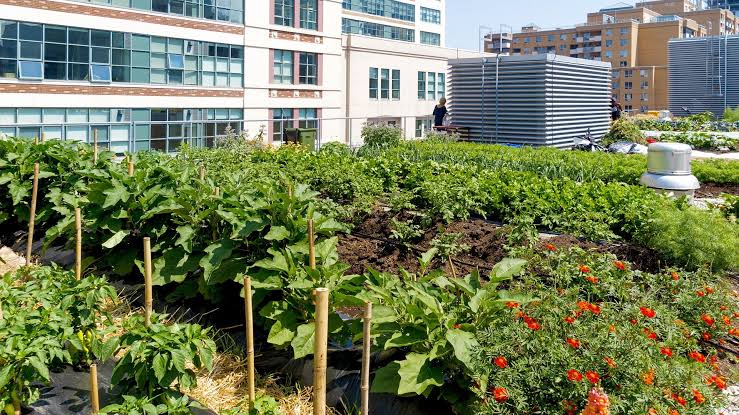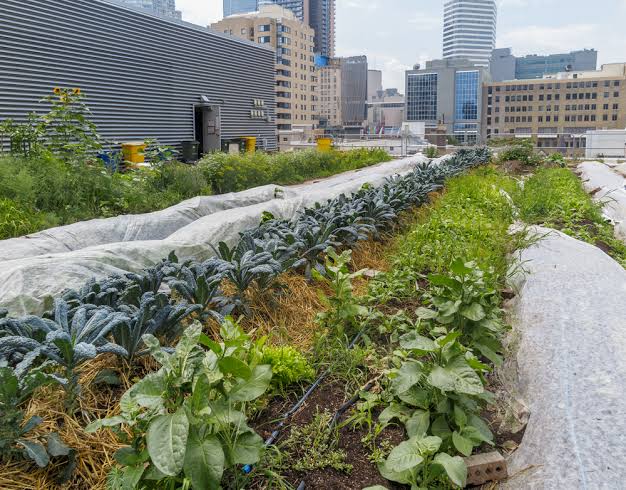Urban farming involves growing plants and raising animals in cities and towns. People do this in various places, such as rooftops, balconies, and even vacant lots. The goal is to bring agriculture closer to where people live, promoting sustainability and local food production.
In urban farming, individuals or communities use creative methods to cultivate crops. They might employ vertical gardening, where plants grow upwards in stacked layers. This maximizes the use of limited space. Window boxes and hanging gardens also contribute to making the most of available room.
One of the advantages of urban farming is that it reduces the distance food needs to travel from farm to table. This means fresher produce and a smaller carbon footprint. Additionally, urban farming can help address food insecurity in densely populated areas by providing a local and affordable source of fresh fruits, vegetables, and herbs.
Community gardens play a significant role in urban farming. These shared spaces allow residents to collectively grow and harvest a variety of crops. They foster a sense of community, with members working together to maintain the garden and share the produce. This not only promotes social interaction but also educates people about where their food comes from and how it is grown.
Urban farming isn’t limited to just plants. Some urban farmers keep small animals like chickens or bees. Chickens provide eggs, and bees help with pollination, benefiting nearby gardens. However, keeping animals in an urban setting requires responsible practices to ensure the well-being of both the animals and the community.
Technology also plays a part in modern urban farming. Hydroponics and aquaponics are methods that involve growing plants without soil, using nutrient-rich water. These systems can be set up indoors, allowing for year-round cultivation. LED lights simulate sunlight, enabling crops to thrive even in spaces with limited natural light.
Besides providing fresh produce, urban farming has broader positive impacts. Green spaces created by these initiatives contribute to improved air quality and overall urban aesthetics. They act as natural buffers, absorbing pollutants and reducing heat in concrete jungles. Urban farms also create job opportunities, from tending to the crops to managing farmers’ markets.
Educational programs and workshops often accompany urban farming initiatives. These aim to teach residents about sustainable practices, gardening techniques, and the importance of locally sourced food. As people become more connected to the food they consume, they are likely to make more informed choices about their diet and its environmental impact.
In addition, urban farming is a dynamic and innovative approach to food production in urban areas. It involves creative solutions to space limitations, fosters community engagement, promotes sustainability, and contributes to the overall well-being of both residents and the environment. As cities continue to grow, the role of urban farming in creating resilient and self-sufficient communities becomes increasingly vital.
Read Also: Russian Blues (Felis catus) Cats Description and Complete Care Guide
Purpose of Urban Farming

The purpose of urban farming encompasses several key goals aimed at addressing challenges in urban areas:
1. Local Food Production: Urban farming seeks to produce food closer to where people live, reducing the distance food needs to travel from farm to table. This promotes fresher and more locally sourced produce.
2. Sustainability: By utilizing innovative farming methods and practices, urban farming aims to be environmentally sustainable. This includes minimizing the use of resources like water and energy while maximizing the efficiency of space.
3. Community Engagement: Urban farming fosters a sense of community by encouraging residents to actively participate in growing and maintaining shared spaces. Community gardens, in particular, become hubs for social interaction and collaboration.
4. Food Security: In densely populated urban areas, access to fresh and affordable produce can be challenging. Urban farming addresses this by creating local sources of food, contributing to increased food security.
5. Environmental Impact: Urban farming contributes to a positive environmental impact by creating green spaces, improving air quality, and reducing the heat island effect in urban environments. Plants play a role in absorbing pollutants and enhancing overall urban aesthetics.
6. Education: Many urban farming initiatives incorporate educational programs to teach residents about sustainable practices, gardening techniques, and the importance of understanding where food comes from. This knowledge encourages more informed and conscious food choices.
7. Job Creation: Urban farming initiatives can generate employment opportunities, ranging from tending to crops and managing community gardens to participating in farmers’ markets. This economic aspect contributes to the overall well-being of urban communities.
8. Resilience: As cities grow and face various challenges, including climate change and resource constraints, urban farming enhances community resilience by creating local, self-sufficient systems for food production.
9. Health and Well-being: Access to fresh, locally grown produce positively influences the health and well-being of urban residents. Urban farming promotes a healthier lifestyle by providing nutritious food options and encouraging outdoor activities.
10. Innovation and Technology: Urban farming embraces technological advancements such as hydroponics, aquaponics, and LED lighting to overcome space limitations and optimize resource use. This innovation contributes to the continuous improvement and adaptability of urban farming practices.
Additionally, the purpose of urban farming is multifaceted, encompassing environmental sustainability, community building, food security, education, job creation, and overall improvements in the well-being of urban populations. It represents a holistic approach to addressing the challenges and opportunities presented by the dynamic nature of urban environments.
Read Also: Oriental Shorthair Cat Breed Description and Complete Care Guide
Economic Benefits of Urban Farming

Here are the key Benefits of Urban Farming to our Economy:
1. Job Creation: Urban farming initiatives generate employment opportunities, from cultivating crops to managing community gardens and participating in farmers’ markets. This contributes to local economic growth and provides income for individuals involved in the urban farming sector.
2. Entrepreneurship Opportunities: Urban farming can empower individuals to start their own small businesses, such as selling fresh produce, herbs, or value-added products derived from urban-grown ingredients. This entrepreneurial aspect supports economic diversity within urban communities.
3. Local Economic Circulation: By promoting local food production and consumption, urban farming helps circulate money within the community. Farmers’ markets and direct sales create economic transactions that stay within the local economy, supporting local businesses and strengthening community ties.
4. Property Value Enhancement: Well-maintained community gardens and green spaces resulting from urban farming efforts can enhance the overall aesthetic appeal of neighborhoods. This, in turn, may positively impact property values and contribute to the economic value of the surrounding area.
5. Cost Savings: Urban farming can lead to cost savings for individuals and communities by providing access to affordable, locally sourced produce. Reduced transportation costs and the elimination of intermediaries in the supply chain contribute to more cost-effective food options for residents.
6. Tourism and Cultural Attractions: Vibrant urban farming initiatives, such as community gardens and farmers’ markets, can become tourist attractions. This influx of visitors can stimulate local economies by increasing demand for local goods, services, and hospitality.
7. Education and Training Opportunities: Urban farming programs often include educational components that provide training in sustainable agricultural practices. This education can create a skilled workforce, enhancing employability and potentially attracting businesses related to agriculture and sustainability.
8. Community Investment: Urban farming fosters a sense of community pride and investment. Residents who actively participate in or benefit from urban farming initiatives may be more inclined to invest time and resources in their local community, contributing to overall community development.
9. Green Job Opportunities: As urban areas prioritize sustainability, there is an increasing demand for green jobs related to environmental conservation and sustainable practices. Urban farming aligns with this trend, creating opportunities for employment in eco-friendly and sustainable occupations.
10. Research and Innovation: The pursuit of efficient and sustainable urban farming practices can drive research and innovation. This can lead to the development of new technologies, products, and methodologies, fostering an environment conducive to economic growth and competitiveness.
The economic benefits of urban farming extend beyond the agricultural sector, encompassing job creation, entrepreneurship, enhanced property values, cost savings, tourism, education, community investment, green job opportunities, and research-driven innovation. These aspects contribute to a more resilient and economically vibrant urban environment.
Environmental Impact of Urban Farming
Below are the ways through urban farming contribute to our environment:
1. Improved Air Quality: Urban farming contributes to enhanced air quality by introducing more green spaces that absorb pollutants and release oxygen. Plants play a crucial role in mitigating air pollution, positively impacting the overall environmental health of urban areas.
2. Carbon Sequestration: Plants absorb carbon dioxide during photosynthesis, helping to mitigate the impact of greenhouse gas emissions. By increasing greenery in urban spaces through farming initiatives, urban areas can contribute to carbon sequestration and reduce their carbon footprint.
3. Reduced Heat Island Effect: The proliferation of green spaces in urban areas created by urban farming helps combat the heat island effect. Plants provide shade and reduce surface temperatures, creating a more comfortable and cooler urban environment.
4. Biodiversity Support: Urban farming, especially when incorporating diverse plant species, can support local biodiversity. Providing habitats for insects, birds, and other wildlife, urban farms contribute to maintaining ecological balance in urban ecosystems.
5. Water Management: Sustainable urban farming practices, such as rainwater harvesting and efficient irrigation methods like drip systems, contribute to better water management. This reduces the strain on local water resources and promotes water conservation.
6. Soil Health Improvement: Urban farming encourages soil health by introducing organic matter and reducing soil erosion. Practices like composting and crop rotation help maintain soil fertility, ensuring a sustainable foundation for plant growth.
7. Waste Reduction: Urban farming often involves composting organic waste to create nutrient-rich soil amendments. This reduces the amount of organic waste going to landfills, contributing to waste reduction and promoting a more circular and sustainable approach.
8. Promotion of Sustainable Practices: Urban farming serves as a platform for promoting and adopting sustainable agricultural practices. This includes organic farming, permaculture, and other environmentally friendly methods that prioritize long-term ecological balance.
9. Pollinator Support: Many urban farms incorporate flowering plants that attract pollinators such as bees and butterflies. This not only benefits crop yields but also supports pollinator populations, which are essential for maintaining biodiversity and ecosystem health.
10. Educational Opportunities: Urban farming initiatives often include educational programs that raise awareness about environmental issues. By engaging the community in sustainable practices, urban farming contributes to building a more environmentally conscious and responsible population.
In summary, the environmental impact of urban farming is multifaceted, encompassing improvements in air and water quality, carbon sequestration, biodiversity support, waste reduction, soil health, and the promotion of sustainable practices. These collective efforts contribute to creating more sustainable and resilient urban environments.
Read Also: Microbiological Examination of Food
